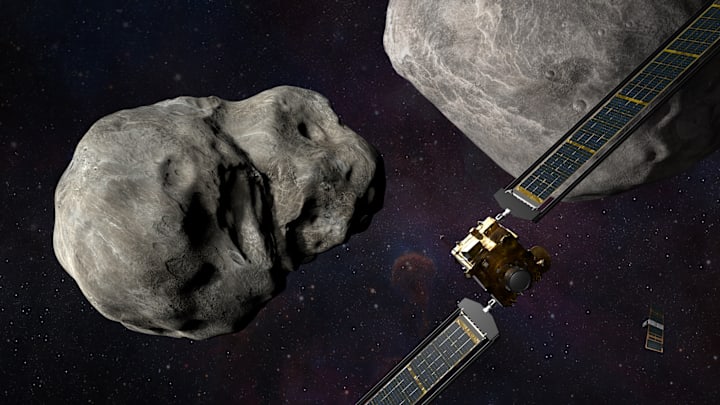Adam McKay’s 2021 Netflix dramedy Don’t Look Up left many viewers pondering an important question: What would we do if a space object with the power to obliterate a planet was headed straight for Earth?
Well, NASA is trying some stuff out.
Meet Dimorphos, a 525-foot-long asteroid orbiting the larger asteroid Didymos, whose diameter stretches roughly half a mile across. Though the system isn’t on a collision course with Earth, it’s only about 6.8 million miles away from us right now—well within the 30-million-mile orbital range that qualifies an asteroid or comet as a “near-Earth object” (NEO). It’s also sizable enough to do some damage if it were headed for Earth. So, as CNN reports, NASA chose it as the test subject for the Double Asteroid Redirection Test, or DART.
Basically, the DART team is planning to crash a spacecraft into Dimorphos to see how much it affects the asteroid’s orbital path. “Scientists think the collision will change the speed of Dimorphos by a fraction of 1 percent,” NASA explained. “It should alter the moonlet’s orbital period around the larger asteroid by several minutes—enough to be observed and measured by telescopes on Earth.” If the mission succeeds in interfering with the asteroid’s trajectory, it bodes well for NASA’s ability to further develop the deflection technology to use on more threatening NEOs in the future.
The DART spacecraft launched back in November 2021, and it’s slated to collide with Dimorphos at 7:14 p.m. EST tonight (Monday, September 26). Traveling with DART are two photographers: DRACO, an onboard imaging and navigational instrument that will capture photos right up to the moment of impact; and the Italian Space Agency’s LICIACube, a satellite that split from the craft earlier this month. LICIACube will document the mission during and after the crash via two cameras: LUKE (LICIACube Unit Key Explorer) and LEIA (LICIACube Explorer Imaging for Asteroid).
Coverage of the event starts at 6 p.m. EST tonight on NASA TV, which you can stream for free on a number of platforms listed here. NASA will also host a Facebook Live event , which you can access here, plus a YouTube livestream that you can tune into below.
[h/t CNN]
